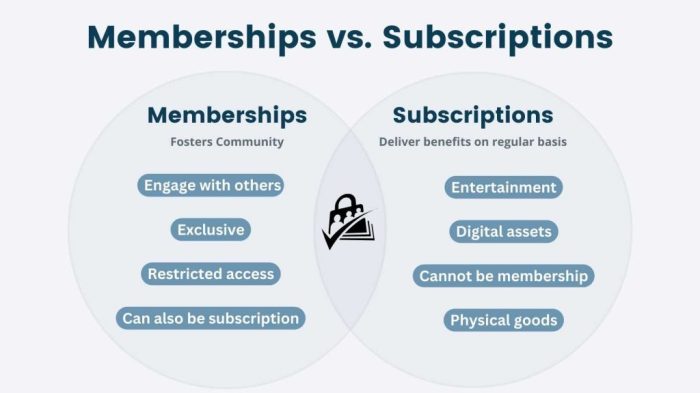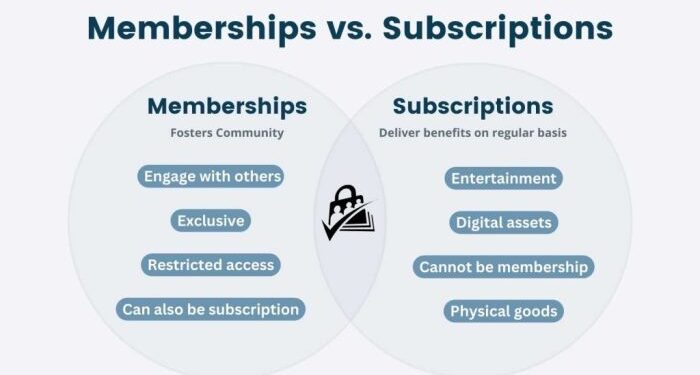Exploring the dynamics of digital life, this discussion delves into the contrast between subscriptions and ownership, shedding light on the economic implications of these choices.
As we navigate through the intricacies of digital consumption, we uncover the evolving landscape of how individuals interact with products and services in a digital realm.
The Concept of Subscriptions vs Ownership
In the digital age, the way we consume products and services has evolved, leading to a shift from traditional ownership to subscription-based models. Let's explore the differences between subscriptions and ownership in the context of digital products and services.
Subscription-based Services and Products
Subscription-based services, such as Netflix, Spotify, and Adobe Creative Cloud, offer users access to a wide range of content or tools for a recurring fee. On the other hand, traditionally owned items like physical books, DVDs, or software licenses require a one-time purchase for permanent ownership.
- Pros of Subscriptions:
- Access to a variety of content or tools without a large upfront cost.
- Regular updates and new features included in the subscription.
- Flexibility to cancel or switch services based on current needs.
- Cons of Subscriptions:
- Long-term costs can accumulate to be higher than a one-time purchase.
- Dependency on the service provider for continued access.
- Potential loss of access if subscription is not maintained.
Economic Impact on Consumers and Businesses
Subscriptions can provide a steady stream of revenue for businesses, leading to predictable cash flow and customer retention. On the other hand, ownership offers consumers the freedom to use products or services without ongoing payments. The economic impact of subscriptions versus ownership depends on factors such as customer loyalty, market trends, and the value proposition of the product or service.
Cost Analysis

The cost analysis between subscriptions and ownership of digital services is crucial in understanding the financial implications of each model. Let's delve into the long-term costs and how they impact consumer behavior and business strategies.
When comparing the expenses of subscribing to digital services versus purchasing and owning them, it is important to consider the cumulative costs over time. While subscriptions may seem more affordable upfront, the recurring payments can add up significantly over months or years compared to a one-time purchase.
Cost Comparison Table
| Time Period | Subscription Model | Ownership Model |
|---|---|---|
| 1 Year | $120/year | $300 (one-time) |
| 3 Years | $360 | $300 (one-time) |
| 5 Years | $600 | $300 (one-time) |
As shown in the table above, the ownership model may have a higher upfront cost, but it can be more cost-effective in the long run compared to subscriptions. Consumers need to consider their usage patterns and how long they plan to use a particular service before deciding between subscription or ownership.
Consumer Behavior and Budgeting
- Subscriptions can lead to a habit of continuous spending, as consumers often overlook the cumulative costs of multiple subscriptions.
- Ownership models encourage more conscious spending decisions, as the upfront cost prompts consumers to evaluate the value and necessity of the purchase.
- Subscription models may also influence impulse buying behavior, as the perception of affordability can lead to subscribing to services that are not essential.
Pricing Strategies
Businesses often price their subscription services competitively to attract customers with the promise of regular updates and new features. This can create a steady revenue stream for the company compared to one-time purchases.
- Subscription pricing is usually structured to be more affordable on a monthly basis to appeal to a broader customer base.
- One-time purchases may be priced higher to reflect the full value of the product or service upfront.
Market Trends and Consumer Behavior
In recent years, there has been a noticeable shift in market trends towards subscription-based models over traditional ownership. This shift has been driven by various factors such as convenience, cost-effectiveness, and access to a wide range of products and services
Current Market Trends
- Many industries, including music streaming, video streaming, software, and even clothing, have seen a rise in subscription-based services. This trend is expected to continue as more companies adopt this model to attract and retain customers.
- Consumers are increasingly valuing access over ownership, preferring to pay a monthly fee for unlimited use of products and services rather than buying and owning individual items.
- Subscription-based models also offer the advantage of regular updates and upgrades, ensuring that consumers always have access to the latest features and content.
Consumer Preferences
- Demographic factors play a significant role in determining whether consumers prefer subscriptions or ownership. Younger generations, such as millennials and Gen Z, tend to lean towards subscriptions due to their digital-native upbringing and desire for flexibility.
- On the other hand, older generations may still prefer ownership, valuing the tangible aspect of owning physical products and feeling a sense of permanence and control.
Psychological Reasons
- Some consumers prefer subscriptions because they offer a sense of freedom and flexibility, allowing them to try out different products without a long-term commitment.
- Others may opt for ownership because it provides a sense of security and control over their possessions, leading to a stronger emotional attachment to the products they own.
Impact on Industry and Innovation
The shift towards subscription-based models has significantly impacted various traditional industries such as media, software, and entertainment. Companies in these sectors are reevaluating their business strategies to adapt to the changing consumer preferences for subscription services.
Media Industry Transformation
- Traditional media companies like newspapers and magazines are moving towards digital subscription models to stay relevant in the digital age.
- Streaming services like Netflix and Hulu have revolutionized the entertainment industry by offering subscription-based access to a wide range of content.
- Podcasts and digital media platforms are leveraging subscription models to monetize their content and engage with their audiences effectively.
Software Sector Evolution
- Software companies have shifted from one-time purchases to subscription-based licensing models, providing customers with regular updates and support.
- Cloud-based software services like Microsoft Office 365 and Adobe Creative Cloud have gained popularity due to their subscription-based pricing and flexibility.
- Open-source software communities are exploring subscription models to sustain development efforts and ensure long-term support for their projects.
Innovation and New Product Development
- Subscription models encourage businesses to innovate constantly to retain and attract subscribers, leading to the development of new digital products and services.
- Companies like Apple and Amazon have introduced subscription services like Apple Music and Amazon Prime, expanding their offerings and enhancing customer loyalty.
- Startups and tech companies are experimenting with subscription boxes and services to deliver personalized experiences to consumers and drive customer engagement.
Successful Transition Examples
- Adobe successfully transitioned from selling software licenses to offering Creative Cloud subscriptions, boosting revenue and customer retention.
- The New York Times shifted to a digital subscription model, increasing its online readership and revenue streams in a challenging media landscape.
- Gaming companies like Xbox and PlayStation have introduced subscription services like Xbox Game Pass and PlayStation Now to provide gamers with access to a vast library of games.
Ultimate Conclusion
In wrapping up our exploration of the economics of digilife, we find that the balance between subscriptions and ownership continues to shape consumer behaviors and industry landscapes in profound ways.
Query Resolution
What are some examples of popular subscription-based services and products?
Some examples include Netflix, Spotify, Adobe Creative Cloud, and Amazon Prime.
How do businesses price their subscription services compared to one-time purchases?
Businesses often offer subscriptions at a lower upfront cost to attract customers, while one-time purchases may have a higher initial price point.
What demographic factors influence the choice between subscribing and owning digital products?
Factors such as age, income level, and tech-savviness can influence whether individuals prefer subscriptions or ownership.





